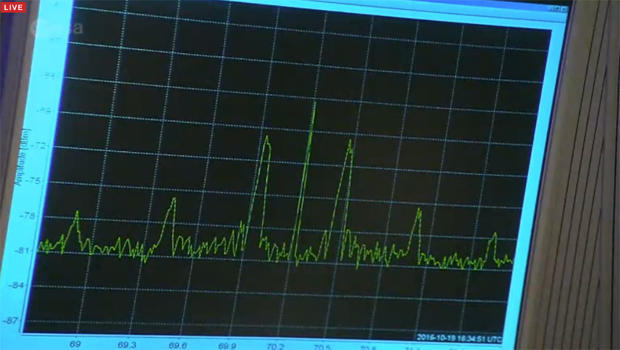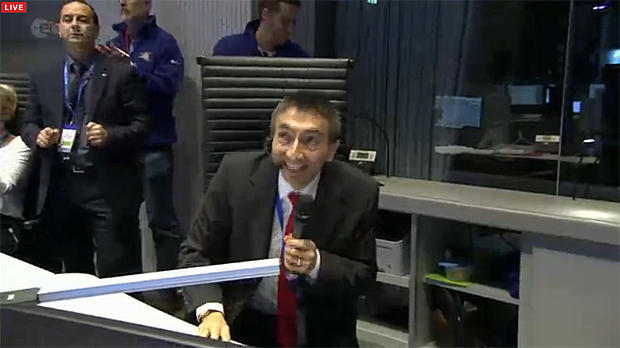European space probe makes nail-biting descent to Mars
On the hunt for evidence of past or present life on Mars, the European Space Agency’s methane-sniffing Trace Gas Orbiter spacecraft successfully braked into orbit around the red planet Wednesday, but radio signals from an lander it released earlier abruptly stopped just before touchdown, leaving its fate uncertain.
The successful orbit insertion maneuver, the result of a 139-minute-long rocket firing to slow the TGO spacecraft enough for Mars’ gravity to capture it an elliptical orbit, was a major milestone for ESA and one of the most ambitious missions yet mounted to look for on Mars.
But the possible loss of the battery-powered Schiaparelli spacecraft, the first Mars lander built by ESA, cast a cloud of uncertainty over ESA’s control center in Darmstadt, Germany. Paolo Ferri, head of mission operations at ESA, said “there could be many reasons” for the sudden loss of the lander’s carrier signal during descent, but “it’s clear these are not good signs.”
He said about 20 megabytes of telemetry from Schiaparelli was stored on board the Trace Gas Orbiter. The data was expected to be downlinked overnight and Ferri said engineers almost certainly would know Schiaparelli’s fate, one way or the other, by Thursday morning.
“Tonight, we look at this telemetry, all the experts here from industry, from ESA, will look at this,” he said. “I’m quite confident tomorrow morning we will know.”
Schiaparelli hit the discernible atmosphere of Mars at an altitude of about 75 miles, traveling at some 13,000 mph, at 10:42 a.m. EDT (GMT-4). Analysis of a carrier signal received on Earth confirmed atmospheric entry nine minutes and 47 seconds after the fact.
Relying on a state-of-the-art heat shield to survive the blazing heat of entry, the small lander quickly decelerated, presumably to a predicted velocity of about 1,000 mph, before deploying a huge supersonic parachute at an expected altitude of just under seven miles to further reduce its vertical velocity.
Then, less than a mile above the surface and descending at a round 155 mph, Schiaparelli’s flight computer was programmed to cut away the parachute and jettison its rear aeroshell, allowing the lander to freely fall on its own. Both events apparently took place as expected based on analysis of Schiaparelli’s carrier signal.
At that point, nine hydrazine-powered thrusters were expected to ignite, stabilizing the spacecraft and reducing the velocity to a few feet per second.
Finally, at an altitude of about 6.5 feet, the engines were programmed to shut down, allowing the lander to drop the rest of the way to the surface in a region known as Meridiani Planum near the equator of Mars, cushioned by a crushable landing structure.
That was the plan, at least.
The lander’s faint carrier signal, transmitted directly to Earth, was picked up by a radio telescope array in India, confirming atmospheric entry, exit from the zone of peak heating, the parachute deployment and release of the lander’s back shell.
But seconds before the anticipated touchdown, the signal was lost and it was not immediately known if the spacecraft braking rockets fired or if it survived the final moments of its descent.
This was not necessarily a surprise, given the predicted -- and realized -- low power of the direct-to-Earth signal. But the sudden silence was nonetheless nerve wracking, forcing engineers, scientists and flight controllers to wait for ESA’s Mars Express satellite to downlink a recorded, much stronger copy of the carrier signal during descent.
“We were tracking ... the signal trace to near arrival on the surface of Mars,” an ESA flight controller said over audio loops at the control center in Darmstadt. “We expected it to continue, but clearly it did not. I think we have to recognize this setup was always going to be an experimental setup, let’s not jump to conclusions.
“Clearly there’s some interesting information here, we need to look at it,” he said. “But we need to wait ... until we get additional data from one of the relay stations. So let’s focus on the next step, look at the more complete data set from one of our relay stations.”
But the Mars Express was no help. After studying its relayed signal, engineers found were unable to draw any conclusions. And there was no immediate word from ESA on the outcome of a pass over the landing site by NASA’s Mars Reconnaissance Orbiter.
Schiaparelli was designed to test entry, descent and landing hardware and software and to collect engineering data needed before ESA can send a much more sophisticated rover to the surface at the end of the decade. The long-range goal of the program is to eventually collect and return samples to Earth for laboratory analysis.
While testing landing technology was Schiaparelli’s primary goal, the spacecraft was equipped with a small suite of science instruments to study martian dust, to measure wind speed and direction, atmospheric humidity, pressure and temperature near the surface as well as atmospheric transparency and electrical fields.
But unlike NASA’s earlier and current solar- and nuclear-powered landers and rovers, Schiaparelli is powered by batteries and was expected to operate on the surface for about one week before losing power. If it survived its descent.
“It’s technology objective is entry, descent and landing of a payload on the surface of Mars,” Alvaro Gimenez, ESA’s director of Science and Robotic Exploration, said before launch. “Orbiting, we have done that before. But this technology objective is very important if you want to be a partner in the future in more missions to Mars.
“If you don’t demonstrate your capability to land, you are not at the right level,” he added. “So we have to demonstrate we can do it ourselves. And that is what we are doing with this one.”
Mars has been a notoriously difficult planet to explore. Of 43 missions launched through 2013 by NASA, the Soviet Union, Russia, India and the European Space Agency, 23 failed outright, 18 succeeded and two were only partially successful. Only eight landers made it to the surface intact, seven operated by NASA and one by Russia.
Regardless of Schiaparelli’s fate, the Trace Gas Orbiter chalked up a near-flawless performance.
As the lander was plunging to the surface, TGO was firing its main engine to reduce its velocity by about 3,470 mph. That allowed the martian gravity to capture the satellite in a highly elliptical four-day orbit with a predicted low point of around 185 miles and a high point beyond 60,000 miles.
The 139-minute burn was still under way when TGO disappeared behind Mars as viewed from Earth. But right on time, its signal resumed on the other side, indicating capture in Mars orbit. Observers and flight controllers in Darmstadt burst into applause.
“Yes, the TGO is captured around Mars and yes, it is in a very nominal orbit of about four days duration,” said ExoMars flight director Denis Michel. “The spacecraft team has confirmed ... it’s all good, it’s a good spacecraft, in the right place and we have a mission around Mars.”
The main engine will fire again in January to lower the high point of the orbit. The spacecraft then will spend nearly a year repeatedly dipping into the thin upper atmosphere of Mars, a procedure known as aerobraking, to lower the high point of the orbit even more.
Finally if all goes well, TGO will end up in a two-hour 250-mile-high circular orbit tilted 74 degrees to the planet’s equator, setting the stage for science operations to commence in December 2017.
The Trace Gas Orbiter features a high-resolution camera system and a suite of spectrometers to look for methane, water vapor, nitrogen and other compounds that could indicate ongoing or past biological activity. A Russian instrument will map hydrogen concentrations on the surface and up to three feet below to locate ice or subsurface water with unprecedented accuracy. Another set of spectrometers will focus on atmospheric chemistry.
“It’s incredibly exciting,” said Elliot Sefton-Nash, an ESA planetary scientist. “Our mission has lofty science goals, it’ll answer some very important questions. But the big thing for me is, we will try to find out if there was ever life or is there still even life on Mars today.”
Methane is a particularly important compound in the search for biological activity. While methane has been detected before on Mars, the measurements were not precise enough to indicate its origin.
“Methane can be produced either by biological activity or by geological processes,” Sefton-Nash said. “And this mission contains instruments that will help distinguish the sources and identify some of the sinks, possibly, of methane. So it will really cast a lot of light on the processes that are affecting the composition of the atmosphere, and how the gases move around.
“We’ll also investigate the chemical signatures that life could have left behind on the surface, which could contain methane. ... This isn’t just about Mars. If we can confirm that life evolved and started somewhere else in our own solar system, what does that mean for other solar systems? What does that mean for other places than our own? It’s really a big question.”
ExoMars 2016 -- TGO and Schiaparelli -- is the European Space Agency’s first attempt to place a lander on the surface of Mars and the first use of “aerobraking” to achieve the desired science orbit. The ExoMars 2018 mission will be Europe’s first attempt to land a rover on the red planet’s surface.
The two missions will cost ESA about $1.5 billion, not counting the cost of the Russian Proton rockets and instruments and contributions by NASA and other agencies.
As initially envisioned, ExoMars was a joint project between NASA and the European Space Agency. But the Obama administration’s 2013 budget request reduced the scope of the U.S. agency’s Mars exploration program, calling the ExoMars missions “unaffordable.”
As a result, NASA backed out of a 2008 agreement with ESA to share the costs of ExoMars, which originally called for launch of an orbiter in 2016 and two rovers in 2018.
With NASA’s withdrawal, the European Space Agency was forced to redesign the ExoMars mission architecture. Russia’s federal space agency, Roscosmos, eventually agreed to supply two Proton launchers in exchange for the addition of Russian instruments aboard TGO and equal access to all data.


